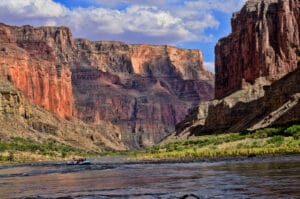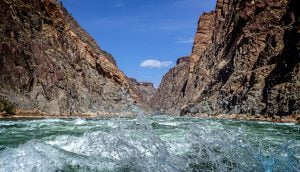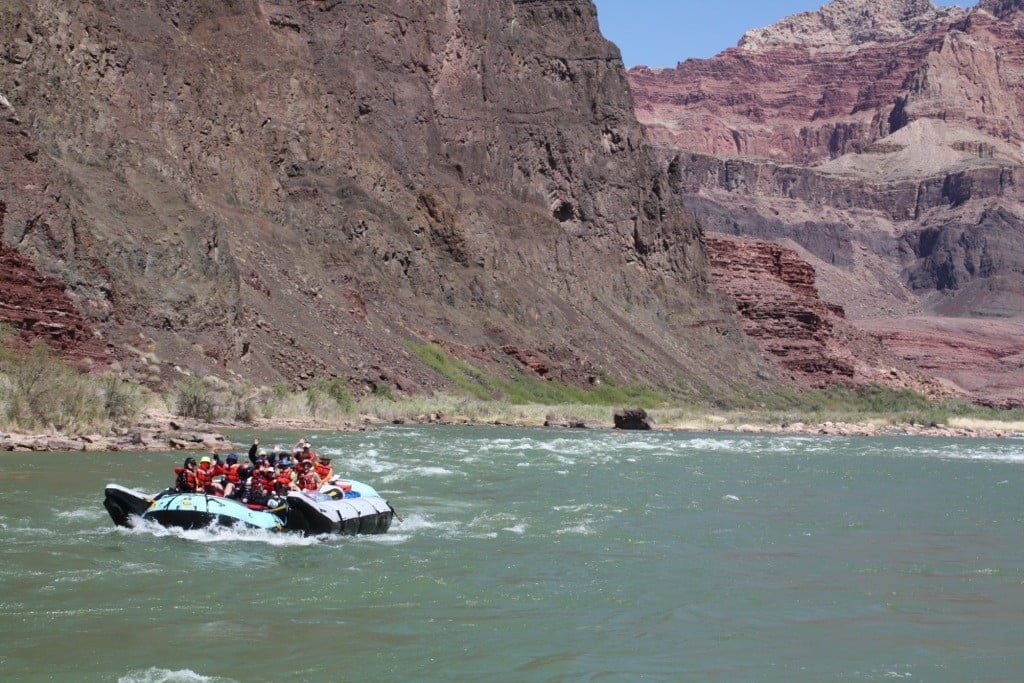Public Meeting February 26th, Salt Lake City Utah

Ever been on a river trip down the Grand Canyon and noticed “the tides” of the Colorado River nearly doubling, and then cut by almost half each day? The Long Term Environmental Monitoring Plan (LTEMP) is well underway and will open for public input in April-May of 2015. From February 25-27th, the Adaptive Management Work Group (AMWG) will meet to discuss the alternatives for the next flow regime. The meeting will be held at the Red Lion in downtown Salt Lake City, and is open to the public. Thursday the 26th will be dedicated to the LTEMP, from 9:00-3:00. Click here for the schedule. Read on to learn why it is important to attend.
Water is the lifeblood of the Grand Canyon. It is the Colorado River and its awesome downcutting power that has revealed 1.8 billion years of geologic record below and between the rims and transported all that material out to sea. While Colorado has been at work for the last 6 million years, all-natural processes in the riparian zone of the canyon were altered in 1963 when the gates of the Glen Canyon Dam were shut. In the blink of an eye –of geologic time- the flow of nutrients and sediment changed, and seasonal fluctuations of water were released each 24-hour period and stripped the canyon of beaches and habitat. A young scientist named David Wegner began to study the effects of the post dam ecosystem. It was his work that led to the Grand Canyon Protection Act of 1992 that stated that Glen Canyon Dam operation could not adversely affect downstream resources. An Environmental Impact Statement (EIS) was conducted, and in 1996 the Record of Decision (ROD) was signed that implemented the Modified Low Fluctuating Flow (MLFF), which continues to dictate canyon flows today.
While the MLFF was a huge improvement in protecting and improving the ecology of the river system, today’s fluctuating flows still swing water levels by up to 80% daily. High Flow Experiments (HFE) were implemented and effectively redistribute and rebuild beaches, but the daily fluctuations continue to erode the sand. After the last 3 HFE’s, I have witnessed the river swirl brown when fluctuations spike for peak power on June 1st, with new beaches, washed downstream. Two steps forward, 1 ½ steps back. Western Area Power Administration (WAPA) who distributes hydropower from Glen Canyon Dam ramps up in peak winter and summer months to meet the power demands of heating and cooling in the desert Southwest. Over the last 3 years, the flow regime has been reevaluated, and today we have an opportunity to improve the environment of Grand Canyon over the next 20 years.
Over $120 million has been spent on science down there so far, but the decision on how to release the water between stakeholders is still unclear. Out of 6 alternatives listed, the Hybrid alternative has emerged as a combination of alternatives supported by the National Park Service, Bureau of Reclamation, basin states and WAPA.
As a board member for Grand Canyon River Guides, I got the opportunity to sit down and meet with Lynn Jenka, an accountant for WAPA and the manager of the Colorado River Storage Project, and Shane Caprone, a Wildlife Biologist with WAPA. Here are some key points I learned in the meeting about the Hybrid alternative, water flows, sediment transportation, and WAPA’s internal workings:
- The Hybrid alternative currently has 24 HFEs scheduled over a 20-year period to help rebuild and maintain beaches for camping and habitat for native fish. These yearly floods are conducted when there has been a heavy sediment input from the Paria River, usually at the end of the monsoon season. The HFEs are also good for the native plants in the riparian zone, as the water can wash out non-native species. The potential length of these floods has been expanded from 96 hours of high flow- to 250 hours- given that conditions are ripe for longer high flows to most effectively distribute the sand.
- WAPA claims that the carbon cost of allowing water through the bypass tunnels during the HFE’s over the 20-year period will be 1.7 billion pounds of CO2 released into the atmosphere. This figure was calculated by a member of the Salt River Project and assumes that the water not moving through the turbines will necessitate the equal amount of power generated through coal burning power plants. This raised a lot of questions among board members at the meeting, who felt that this calculation didn’t account for opportunities to offset potential hydropower with renewable energies- and the decreasing costs of solar power production. It also doesn’t consider conservation, where power users could use less energy.
- Within the Hybrid, fluctuations will continue to rise and fall by 8,000 cfs. But Shane Caprone explained to us that it isn’t the fluctuations that are eroding the beaches, it is the total monthly volume of water released that is devastating to the beaches. While flows below 12,000 c.f.s are found to have minimal erosional capabilities, flows above 12,000 erode sand at an exponential rate, to the 3rd The Hybrid as currently discussed, evens out the monthly spikes of water flow throughout the year. This plan will retain 70 metric tons of sediment more than the existing MLFF. Discussion/ questions for the upcoming meeting:
- HFEs are crucial to rebuild beaches and maintain habitat in Grand Canyon. Will the biased/skewed statistic relating to carbon emissions lead to less HFEs? Turbines could be built in the bypass tunnels for a cost between $20-30 million. How long would it take to pay off this cost?
- Do we really need to continue fluctuating flows by up to 80%? In our meeting, WAPA representatives told us that the price paid for power generated by Glen Canyon Dam is the same for peak and off-peak production. How much more sediment could we retain if fluctuations were maxed at 4,000 c.f.s? Foreshadowing a last-minute move to increase fluctuations even more, Shane told us that fluctuation swings of 10,000 or 12,000 wouldn’t erode much more sand. What are the ecological impacts of fluctuating the Colorado by 120%? Certainly it would have negative impacts on river trips, with boats getting beached at camp, and lower flows at the bottom end of fluctuations to navigate the river.
So what can we do to ensure the right decision is made? Come to the meeting at the Red Lion, Thursday February 26th starting at 8:00 AM. Make a public comment by emailing Glen Knowles at least 5 days before the meeting at gknowles@usbr.gov, and state that HFEs should be priority, and fluctuations should be kept to a minimum. Sign up for email notifications for when the draft EIS opens for public input in April/May. Power production was only a secondary thought after Glen Canyon Dam was built. There is only one Grand Canyon. We need to do what we can to protect the natural wonders of the world.
-Ben






